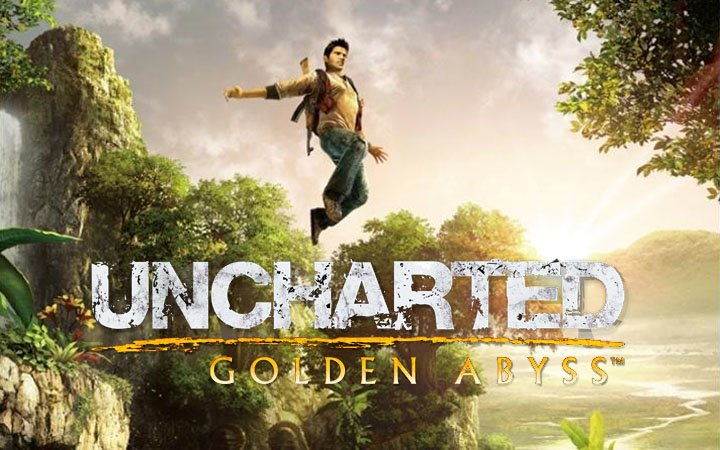Few can deny that the Uncharted franchise has revolutionized the gaming space as we know it. These games have sold millions of consoles for Sony, and has now been tasked with headlining the new Playstation Vita. However, this time the franchise has changed hands from the original creators, Naughty Dog, who were busy with Uncharted 3: Drakes Deception, to Bend Studio, creators of Syphon Filter. This was  a tremendous change, but was Bend Studio up to standing in for the mighty Naughty Dog?
a tremendous change, but was Bend Studio up to standing in for the mighty Naughty Dog?
Uncharted: Golden Abyss starts out as most Uncharted games do: with Nathan Drake being called in by a friend. This time around, his old friend, Jason Dante, is doing some excavating and comes across some strange symbols. Jason invites Drake to the site as an expert. While at the site, Nathan meets Marisa Chase, an archaeologist helping with the excavation. As always, things soon turn ugly when a local warlord claims the site as his own. After escaping the army, the focus of the game switches to Marisa and her lost father. Nathan and Marisa decide to find Marisa’s father and continue his work in uncovering the mystery behind a 400-year-old massacre.
Those expecting this game to follow in the footsteps of the acclaimed Playstation 3 exclusives will find a game that has the same flavor as the other Uncharted games, but is certainly a different game. Visually speaking, this game looks impressive on the Playstation Vita. The colors are bright and vibrant, and the game certainly looks the part. Whether Drake is running through a burning building on the brink of exploding or traversing the canopies of a South American jungle, the visuals never falter. The Vita is certainly put to the test, and it is safe to say that the handheld does remarkably well in this regard.
The controls in this game are just as strong as the visuals. You have the option to use the button and stick combinations of the original franchise, but you can also take advantage of the new, Vita-enhanced controls, which utilize the touch screens and accelerometers. The traditional button and stick combination works and feels similar to the PS3 controller. There were a few occasions, especially in combat, where the button controls didn’t work as well as you would expect. It is particularly hard to run-and-gun if you are used to the traditional scheme, but it works well overall. The gun play is certainly a high point to this game and feels very close to the original. Swapping weapons, aiming, and stealth attacks all feel fluid and work well. If you are daring enough to give the new control scheme a try, you may find that the game works even better on the handheld than it does on the console. The touch mechanics work remarkably well in the platforming sections of the game. Drake is able to move wherever you want him to go quickly and easily. The best addition was the “painting a path” mechanic, where you draw a line for Drake to follow on the platforms. As long as you are physically able to move along that line, Drake moves quickly, speeding up the gameplay.
screens and accelerometers. The traditional button and stick combination works and feels similar to the PS3 controller. There were a few occasions, especially in combat, where the button controls didn’t work as well as you would expect. It is particularly hard to run-and-gun if you are used to the traditional scheme, but it works well overall. The gun play is certainly a high point to this game and feels very close to the original. Swapping weapons, aiming, and stealth attacks all feel fluid and work well. If you are daring enough to give the new control scheme a try, you may find that the game works even better on the handheld than it does on the console. The touch mechanics work remarkably well in the platforming sections of the game. Drake is able to move wherever you want him to go quickly and easily. The best addition was the “painting a path” mechanic, where you draw a line for Drake to follow on the platforms. As long as you are physically able to move along that line, Drake moves quickly, speeding up the gameplay.
In addition to movement, there are a number of new information-gathering mechanics that have been added to show off the Vita‘s capabilities and bring a new dimension of gameplay to an old franchise. Throughout the game, you will come across artifacts or collect clues that require you to use the touch screen. At several points in the campaign, you will have to take a charcoal rubbing of a stone, requiring you to rub your finger across the screen, or you’ll find a dirty Spanish helmet that you’ll have to polish with your finger. These touch mechanics are appealing in theory, but they ultimately slow the gameplay down. Having to constantly rub your finger over objects feels like a gimmick rather than something that is going to make the game more immersive. At several points, you will  have to solve puzzles by piecing a torn piece of paper back together or repairing a broken object. Granted, these puzzles are better than the aforementioned rubbing mechanic, but it still slows the gameplay down. The puzzles feel removed from the rest of the story, and it just fails to compare to their more advanced console contemporaries.
have to solve puzzles by piecing a torn piece of paper back together or repairing a broken object. Granted, these puzzles are better than the aforementioned rubbing mechanic, but it still slows the gameplay down. The puzzles feel removed from the rest of the story, and it just fails to compare to their more advanced console contemporaries.
Unfortunately, there is no multiplayer for this game. This is surprising considering how popular the multiplayer modes have become in Uncharted 2 and 3. This would be a much better game if we were able to enjoy Uncharted‘s signature competitive or cooperative multiplayer on the road. Sadly, this fault is a fair representation of Uncharted: Golden Abyss; a missed opportunity. Sure, this game has some brilliant moments and elements that were well thought out, but they fail to come together in the long run. The set pieces are amazing, but it fails to use them often enough. The voice acting is great, but the dialogue isn’t engaging. The gun play is fun and works well, but some of the touch mechanics get in the way. This game definitely wants to be as good as its Naughty Dog counterpart, but it ultimately fails to do so.
Overall, Uncharted: Golden Abyss is a good game. It manages to show off the Vita‘s potential nicely while still giving gamers a fun Uncharted experience. While it doesn’t compare favorably against the titles we know and love, it does manage to get tantalizingly close. Though this title is not good enough to move a large amount of systems, it is still a worthy addition to any Vita owner’s collection.
Rating: 











